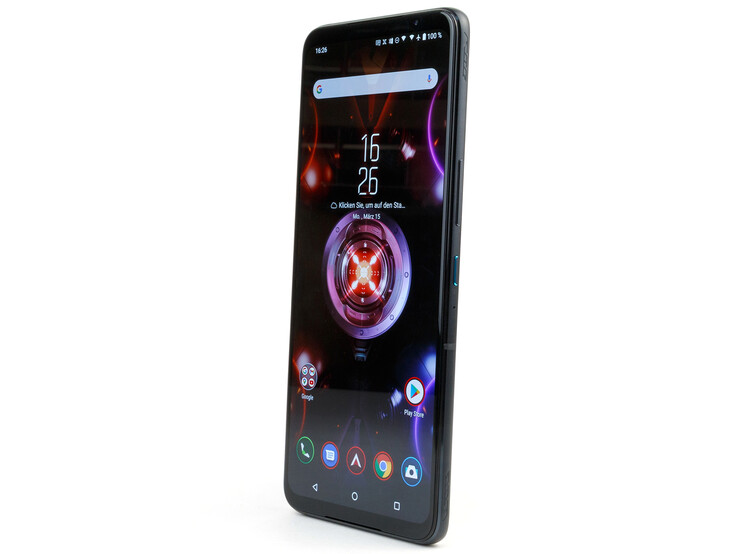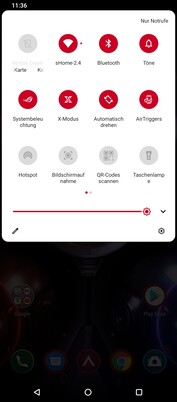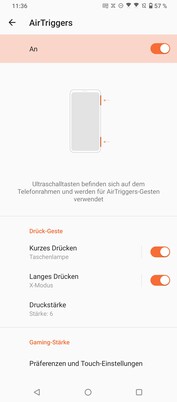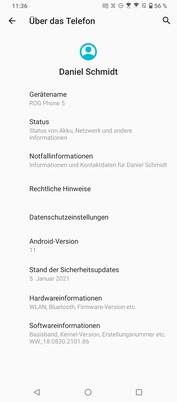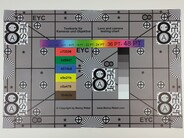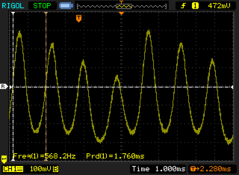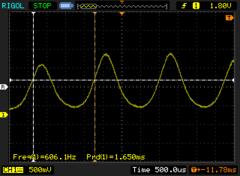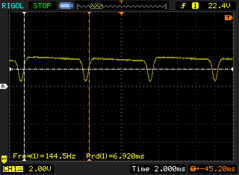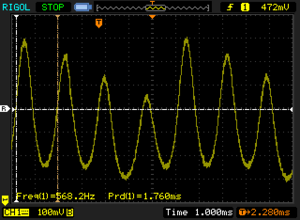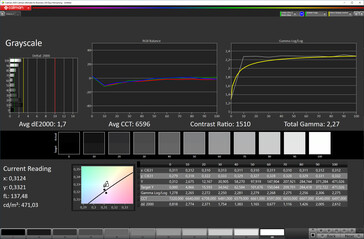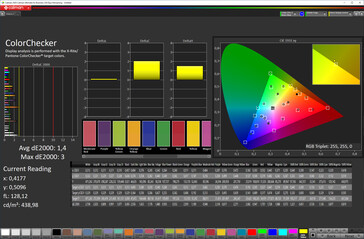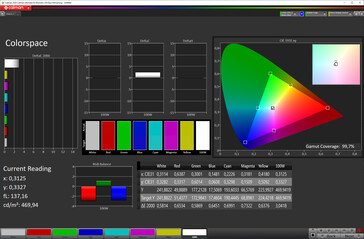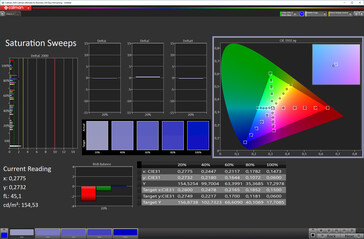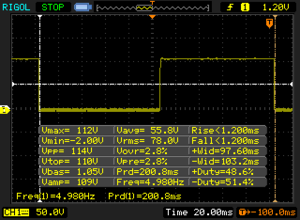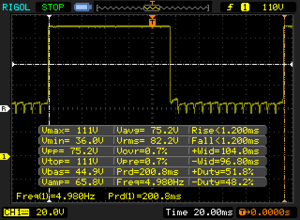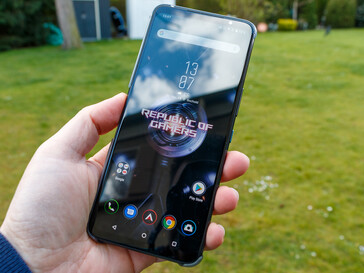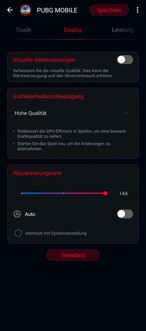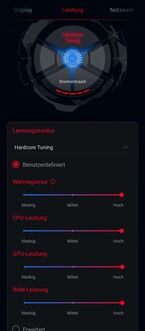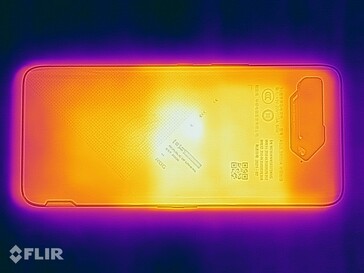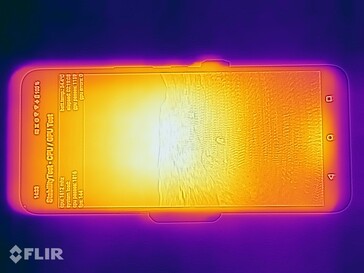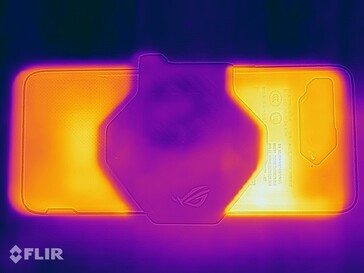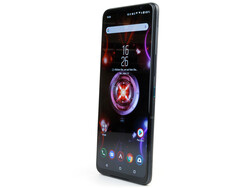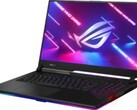Asus ROG Phone 5 review: The king of gaming smartphones
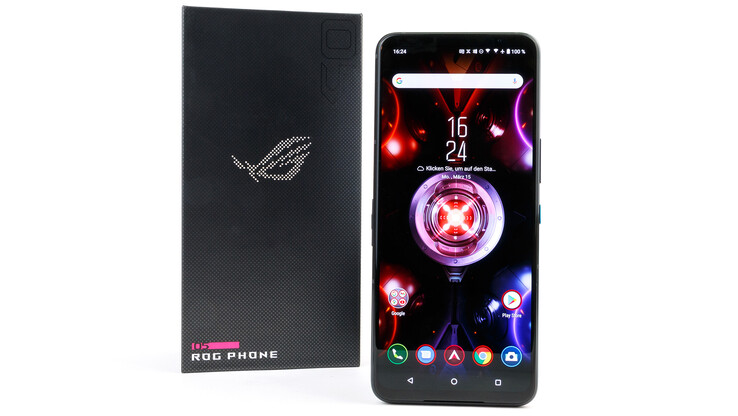
The ROG Phone 3 is followed by the ROG Phone 5; as expected, the latter is equipped with Qualcomm's latest top-of-the-line SoC and offers many improvements compared to the predecessor. However, the biggest innovations have been reserved for the upcoming ROG Phone 5 Pro and Ultimate, which feature additional touch sensors on the back. In addition, a small PMOLED display has been implemented on the back instead of an RGB dot-matrix one.
Nevertheless, small compromises have to be made because the ROG Phone 5 is no longer shipped with an attachable fan. This has to be purchased separately now. With the Snapdragon 888, it's based on the latest technology and promises top performance. The smartphone has 12 or 16 GB of RAM and 256 GB of UFS 3.1 storage, which still can't be expanded. The camera setup, which is identical to the predecessor, is a bit disappointing. In return, the audio jack is back, and it promises good sound due to the support of Quad DAC.
Possible contenders in comparison
Rating | Date | Model | Weight | Drive | Size | Resolution | Price |
|---|---|---|---|---|---|---|---|
| 88 % v7 (old) | 04 / 2021 | Asus ROG Phone 5 SD 888 5G, Adreno 660 | 239 g | 256 GB UFS 3.1 Flash | 6.78" | 2448x1080 | |
| 90.4 % v7 (old) | 02 / 2021 | Samsung Galaxy S21 Ultra Exynos 2100 5G, Mali-G78 MP14 | 227 g | 128 GB UFS 3.1 Flash | 6.80" | 3200x1440 | |
| 84.2 % v7 (old) | 06 / 2020 | Nubia RedMagic 5G SD 865, Adreno 650 | 218 g | 256 GB UFS 3.0 Flash | 6.65" | 2340x1080 | |
| 88.9 % v7 (old) | 03 / 2021 | Oppo Find X3 Pro SD 888 5G, Adreno 660 | 193 g | 256 GB UFS 3.1 Flash | 6.70" | 3216x1440 | |
| 89.1 % v7 (old) | 09 / 2020 | Asus ROG Phone 3 Strix Edition SD 865, Adreno 650 | 240 g | 256 GB UFS 3.1 Flash | 6.59" | 2340x1080 |
Case - Massive glass body
The Asus ROG Phone 5 is almost as heavy as its predecessor, and it weighs exactly one gram less. In addition to the familiar black design, a white variant is now available for the first time.
The display is now protected with Corning Gorilla Glass Victus, and the back with Gorilla Glass 3. The latter no longer offers a view of the heat sink, but it still features a customizable RGB dot-matrix display, which can also show two colors at the same time now.
The build quality of the ROG Phone 5 is hardly a cause for criticism. The gap dimensions are close-fitting and even, and the camera hump is comparatively flat at a height of 1.05 millimeters. However, Asus specifies a rough estimate for the thickness in order to stay below 1 centimeter, since we measured 10.45 millimeters without the camera. Despite the bulky dimensions, the smartphone can be twisted quite easily, and it grunts and creaks audibly.
The batteries of the ROG Phone are firmly built into the device, and they can't be replaced by the user. There's no special protection against dust and water ingress.
Connectivity - Audio jack with high-res Quad DAC in the ROG Phone 5
The port on the side for the optional Aeroactive Cooler 5 only consists of pogo pins, and a full-fledged USB 3.2 port (Gen. 2) is now located right next to it, which also supports image output to DisplayPorts and HDMI ports in Ultra HD resolution. Another port (USB 2.0) is found on the bottom edge; both ports support QuickCharge as well as Power Delivery 3.0, but only the one on the side can handle QC 5.0.
The AirTrigger5 buttons use ultrasonic sensors to detect pressure and touch inputs. The two surfaces on the right side are mainly used to control games, but the ROG Phone also supports squeezing the smartphone like some devices from HTC or Google did in the past. The feature can be customized in the settings, and it can trigger different functions or launch apps.
Unlike the predecessor, the ROG Phone 5 brings back the audio jack, and it promises a high-resolution audio output thanks to the Quad DAC ESS Sabre ES9280AC Pro. Besides a notification LED, an always-on display is implemented as well.
Software - Asus smartphone with Android 11 and ROG UI
The Asus ROG Phone 5 ships with Google's Android 11, and the Taiwanese have put their proprietary ROG UI on top of it. If you don't like it, you can also select a classic Vanilla look during the setup.
With X Mode, users once again get useful tools with which they can completely tune the ROG Phone 5 for gaming. Distracting notifications can be blocked, brightness can be controlled, and AirTrigger can be configured. In addition, it's possible to define individual settings for each game, be it the display refresh rate, the touch sensitivity, or the network configuration. A screen recording tool is also integrated directly into the system. A new feature is the eSports mode, which limits several additional functions during tournaments so that the user doesn't gain any advantages in the competition.
Communication and GNSS - Dual WLAN and accurate positioning
The Asus ROG Phone 5 supports dual-band Wi-Fi. Not only does this mean that the Wi-Fi 6E module can handle multiple frequency bands in this case, but it can actually connect to multiple networks at the same time so as to ensure better network stability. Speed is already very stable in single-band operation in combination with our Netgear Nighthawk AX12 reference router, and it allows high data transfer rates.
The ROG Phone 5 can access the Internet using all the latest mobile network standards; you'll only be missing out on mmWave for 5G. However, the presumed standard version takes the role of last year's Strix Edition in this respect, since it offers support for fewer frequency bands and slightly lower maximum data transfer rates compared with the Pro and Ultimate versions. However, the latter only applies to the maximum download speed on LTE, which allows a maximum of 1.4 Gb/s in the standard variant tested here, while the more expensive versions offer up to 2.0 Gb/s.
Asus makes full use of the supported satellite navigation systems (GNSS), and it can access GPS (dual-band), GLONASS (single-band), BeiDou (triple-band), QZSS (dual-band), Galileo (dual-band), and NavIC (single-band). As a result, the satellite fix is very fast even indoors.
The ROG Phone 5 has to face the comparison with the Garmin Edge 500 on a short test drive, and especially in the area of the turning point between the houses, it shows considerably more accurate positioning than the bike computer. Therefore, the Asus smartphone should be optimally equipped in this regard.
Telephone and call quality
The four integrated microphones promise good voice quality, and they can also convince in everyday use. When held to the ear, the user of the Asus ROG Phone 5 can be understood very well, their voice is reproduced naturally, and minor noise is filtered out reliably. On the other hand, loud ambient noise results in distorted voice reproduction, although the ROG user remains intelligible. The speaker has a decent range, but it reverberates slightly.
The Asus smartphone can accommodate two nano SIM cards, but it doesn't support an eSIM. VoLTE is also on board, but WLAN calls are not. In return, SIP accounts can be configured and managed directly in the phone app. Furthermore, a call-recording function is implemented too.
Cameras - Nothing has changed in the ROG Phone 5
New smartphone, old cameras! Nominally, there are no changes compared with the predecessor, even the Sony IMX686 main sensor is identical. We haven't seen that in this price range yet. In Asus's defense, it should be mentioned that the product cycle was quite short this time, and although the camera is certainly not at the top among smartphones, it still provides good pictures.
In daylight, the photos taken with the ROG Phone 5 are consistent and quite balanced, and Asus doesn't overdo it in terms of post-sharpening. However, blurry pixel areas can occur with larger color surfaces. Zooming is only possible digitally and up to a maximum of 8x. The ultra wide-angle lens has distortion correction and delivers decent results. While the macro lens is quite nice, the main camera allows for better results with a slightly larger distance and 2x magnification.
Videos are recorded in 8K (30 FPS) at best, and they don't have a duration limit. Ultra HD or Full HD are available for those who want to shoot at 60 FPS. The lack of an optical image stabilizer is a pity.
Image comparison
Choose a scene and navigate within the first image. One click changes the position on touchscreens. One click on the zoomed-in image opens the original in a new window. The first image shows the scaled photograph of the test device.
Wide angleWide angleUltra wide angleZoom (5x)Low light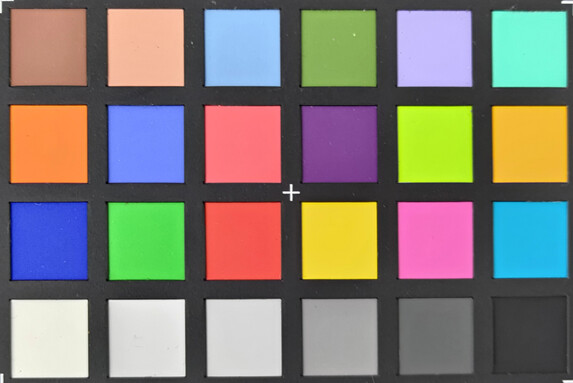

Accessories and warranty - Powerful charger but no fan
The box of the Asus ROG Phone 5 includes a protective plastic case, a fabric-covered USB cable, a SIM tool, and a 65-watt HyperCharger.
Among other things, the AeroActive Cooler 5 is optionally available; the predecessor's fan adapter isn't compatible due to the modified port. For the same reason, the TwinView Dock 3 and the Mobile Desktop Dock can no longer be used. Other existing accessories can still be used with the ROG Phone 5.
Input devices and handling - Squeeze, tap, swipe
Not only does the Asus ROG Phone 5 have a high refresh rate of up to 144 Hz, but the touch sampling rate of 300 Hz is also very high, and it promises a fast response to inputs on the capacitive touchscreen with a latency of 24.3 milliseconds. The gliding properties of the Gorilla Glass Victus are very good.
The ultrasonic sensors on the smartphone's sides, which are called AirTrigger 5, have been further improved. Each touch field is now divided into two small zones, which can also be configured separately. Furthermore, the number of sensors has been increased from seven to nine in order to ensure even better accuracy. Their configuration is again done using X mode, and an individual configuration can be performed for each game. The same sensors also recognize pressure gestures when the system is running and can distinguish between a long and short squeeze, which can be combined with different actions. For example, Google Assistant, the flashlight, or the camera app can be launched. Those who opt for the Pro or Ultimate variant get two additional touch sensors on the back.
An optical fingerprint scanner integrated into the display is available for biometric security. It offers quite reliable recognition rates, but it's not one of the fastest. 2D facial recognition using the front-facing camera works faster and is more convenient, but it's also less secure. The vibration motor's haptic feedback is crisp, precise, and acoustically discreet.
Display - 144 Hz AMOLED and limited DC dimming
The Asus ROG Phone 5 has a 6.78-inch (17.22 cm) AMOLED display from Samsung with a resolution of 2448x1080 pixels. The display refresh rate can be set to 60, 120, or 144 Hz. However, the existing mechanism is not adaptive like in the Galaxy S21 Ultra, for example, but it only switches automatically between these three modes. X Mode also allows the refresh rate to be set individually for each game.
Asus specifies the panel brightness at 800 cd/m², which is fairly in line with the value that we measure when the ambient light sensor is active and a completely white image is shown on the display. With an even distribution of bright and dark areas, the ROG smartphone reaches 1,088 cd/m² in the center of the screen in the APL50 test and 1,136 cd/m² in APL10. If you adjust the brightness manually, you have 488 cd/m² at your disposal. The minimum brightness is also in line with the manufacturer's specifications and has been reduced considerably compared with the ROG Phone 3, but we would have liked it to be even dimmer. The panel supports HLG, HDR10, and HDR10+.
DC dimming is not implemented well at the time of our test, because no difference can be seen when it's activated. Furthermore, its use is limited to a refresh rate of 60 Hz. This is an area where Asus needs to make some urgent improvements.
OLED flickering exhibits a bumpy amplitude curve at low panel brightness and fluctuates between 193.8 and 568.2 Hz at minimum display brightness. This fluctuation is hardly noticeable above 22% of the available brightness (574.7 - 606.1 Hz), and as soon as the 68% mark is exceeded, the panel uses a fixed 144 Hz. Therefore, sensitive users should expect discomfort when reading in the dark. However, since the display brightness is always set a bit higher when gaming, this can still be done without issues.
| |||||||||||||||||||||||||
Brightness Distribution: 98 %
Center on Battery: 789 cd/m²
Contrast: ∞:1 (Black: 0 cd/m²)
ΔE ColorChecker Calman: 1.4 | ∀{0.5-29.43 Ø4.78}
ΔE Greyscale Calman: 1.7 | ∀{0.09-98 Ø5}
99.7% sRGB (Calman 2D)
Gamma: 2.27
CCT: 6596 K
| Asus ROG Phone 5 AMOLED, 2448x1080, 6.8" | Samsung Galaxy S21 Ultra Dynamic AMOLED 2X, 3200x1440, 6.8" | Nubia RedMagic 5G OLED, 2340x1080, 6.7" | Oppo Find X3 Pro AMOLED, 3216x1440, 6.7" | Asus ROG Phone 3 Strix Edition AMOLED, 2340x1080, 6.6" | |
|---|---|---|---|---|---|
| Screen | -8% | -215% | 13% | -39% | |
| Brightness middle (cd/m²) | 789 | 910 15% | 593 -25% | 759 -4% | 625 -21% |
| Brightness (cd/m²) | 795 | 913 15% | 601 -24% | 776 -2% | 630 -21% |
| Brightness Distribution (%) | 98 | 98 0% | 92 -6% | 94 -4% | 88 -10% |
| Black Level * (cd/m²) | |||||
| Colorchecker dE 2000 * | 1.4 | 2 -43% | 8.1 -479% | 0.8 43% | 2.6 -86% |
| Colorchecker dE 2000 max. * | 3 | 3.1 -3% | 16.2 -440% | 1.8 40% | 4.5 -50% |
| Greyscale dE 2000 * | 1.7 | 2.2 -29% | 7.1 -318% | 1.6 6% | 2.5 -47% |
| Gamma | 2.27 97% | 2.06 107% | 2.28 96% | 2.23 99% | 2.22 99% |
| CCT | 6596 99% | 6512 100% | 7566 86% | 6512 100% | 6750 96% |
* ... smaller is better
Screen Flickering / PWM (Pulse-Width Modulation)
| Screen flickering / PWM detected | 568 Hz | ≤ 22 % brightness setting | |
The display backlight flickers at 568 Hz (worst case, e.g., utilizing PWM) Flickering detected at a brightness setting of 22 % and below. There should be no flickering or PWM above this brightness setting. The frequency of 568 Hz is quite high, so most users sensitive to PWM should not notice any flickering. In comparison: 53 % of all tested devices do not use PWM to dim the display. If PWM was detected, an average of 8111 (minimum: 5 - maximum: 343500) Hz was measured. | |||
The Standard default display profile shows a very cool reproduction in the CalMAN software and covers the DCI-P3 color space almost completely. Users who prefer a more natural color reproduction should switch to the Natural profile. Although it only uses the smaller sRGB color space, it reproduces both colors and grayscales very accurately. The Cinema mode is only marginally worse, but it also uses DCI-P3.
Display Response Times
| ↔ Response Time Black to White | ||
|---|---|---|
| 2.4 ms ... rise ↗ and fall ↘ combined | ↗ 1.2 ms rise | |
| ↘ 1.2 ms fall | ||
| The screen shows very fast response rates in our tests and should be very well suited for fast-paced gaming. In comparison, all tested devices range from 0.1 (minimum) to 240 (maximum) ms. » 11 % of all devices are better. This means that the measured response time is better than the average of all tested devices (20.2 ms). | ||
| ↔ Response Time 50% Grey to 80% Grey | ||
| 2.4 ms ... rise ↗ and fall ↘ combined | ↗ 1.2 ms rise | |
| ↘ 1.2 ms fall | ||
| The screen shows very fast response rates in our tests and should be very well suited for fast-paced gaming. In comparison, all tested devices range from 0.165 (minimum) to 636 (maximum) ms. » 10 % of all devices are better. This means that the measured response time is better than the average of all tested devices (31.6 ms). | ||
Performance - Snapdragon 888 with optional cooling
All versions of the Asus ROG Phone 5 use Qualcomm's latest top-of-the-line SoC, the Snapdragon 888. Our review sample has access to a generous 16 GB of LPDDR5 memory, and even up to 18 GB is possible in the Ultimate version. The integrated Adreno 660 is used for graphics processing.
The performance is slightly higher than that of other smartphones with this SoC, which is mainly due to better cooling. In Geekbench, the compute score with the Vulkan API is 27% higher, which indicates better driver optimization.
The system speed is very high in PCMark and easily beats the Find X3 Pro, among others, which also makes use of the Snapdragon 888, but it can't outperform its own predecessor.
| UL Procyon AI Inference for Android - Overall Score NNAPI (sort by value) | |
| Asus ROG Phone 5 | |
| Samsung Galaxy S21 Ultra | |
| Average Qualcomm Snapdragon 888 5G (9372 - 32288, n=6) | |
| Average of class Smartphone (3769 - 81594, n=139, last 2 years) | |
The Asus ROG Phone 5 really goes full throttle in the browser benchmarks and easily dominates the comparison field. Browsing is also smooth in everyday use, and websites are loaded quickly.
| JetStream 1.1 - Total Score | |
| Asus ROG Phone 5 (Chrome 89) | |
| Average Qualcomm Snapdragon 888 5G (77 - 223, n=19) | |
| Oppo Find X3 Pro (Chrome 89) | |
| Samsung Galaxy S21 Ultra (Chrome 88) | |
| Asus ROG Phone 3 Strix Edition (Chrome 84) | |
| Nubia RedMagic 5G (Chrome 83) | |
| WebXPRT 3 - Overall | |
| Average of class Smartphone (38 - 380, n=35, last 2 years) | |
| Asus ROG Phone 5 (Chrome 89) | |
| Average Qualcomm Snapdragon 888 5G (103 - 182, n=18) | |
| Samsung Galaxy S21 Ultra (Chrome 88) | |
| Oppo Find X3 Pro (Chrome 89) | |
| Asus ROG Phone 3 Strix Edition (Chrome 84) | |
| Nubia RedMagic 5G (Chrome 83) | |
| Octane V2 - Total Score | |
| Average of class Smartphone (2228 - 121337, n=201, last 2 years) | |
| Asus ROG Phone 5 (Chrome 89) | |
| Average Qualcomm Snapdragon 888 5G (23491 - 47543, n=20) | |
| Oppo Find X3 Pro (Chrome 89) | |
| Samsung Galaxy S21 Ultra (Chrome 88) | |
| Asus ROG Phone 3 Strix Edition (Chrome 84) | |
| Nubia RedMagic 5G (Chrome 83) | |
| Mozilla Kraken 1.1 - Total | |
| Nubia RedMagic 5G (Chrome 83) | |
| Asus ROG Phone 3 Strix Edition (Chrome 84) | |
| Samsung Galaxy S21 Ultra (Chrome 88) | |
| Oppo Find X3 Pro (Chrome 89) | |
| Asus ROG Phone 5 (Chrome 89) | |
| Average Qualcomm Snapdragon 888 5G (891 - 1841, n=20) | |
| Average of class Smartphone (257 - 28190, n=156, last 2 years) | |
* ... smaller is better
The ROG Phone 5 uses fast UFS 3.1 storage, which promises high performance. This is demonstrated impressively in the test. Only in the area of sequential writing does the storage drive not reach its full potential, but this can also be attributed to the SoC's memory controller, since no smartphone with the Snapdragon 888 has been able to succeed in this so far.
| Asus ROG Phone 5 | Samsung Galaxy S21 Ultra | Nubia RedMagic 5G | Oppo Find X3 Pro | Asus ROG Phone 3 Strix Edition | Average 256 GB UFS 3.1 Flash | Average of class Smartphone | |
|---|---|---|---|---|---|---|---|
| AndroBench 3-5 | 10% | -30% | -4% | -5% | 16% | 45% | |
| Sequential Read 256KB (MB/s) | 1779 | 1710 -4% | 1654 -7% | 1779 0% | 1697 -5% | 1757 ? -1% | 2223 ? 25% |
| Sequential Write 256KB (MB/s) | 795 | 1077 35% | 388.4 -51% | 759 -5% | 770 -3% | 1204 ? 51% | 1838 ? 131% |
| Random Read 4KB (MB/s) | 291.4 | 316.7 9% | 201.6 -31% | 273.3 -6% | 266.8 -8% | 287 ? -2% | 295 ? 1% |
| Random Write 4KB (MB/s) | 278 | 279.5 1% | 193.6 -30% | 267.1 -4% | 268.5 -3% | 318 ? 14% | 335 ? 21% |
Games - ROG Phone 5 for ultimate control
The Adreno 660 lays the foundation for the strong gaming performance of the Asus ROG Phone 5, but it's mainly the additional hardware and software features of the smartphone that can provide gamers with a decisive advantage in PvP scenarios.
The gaming smartphone can certainly deliver when it comes to performance, and it proves to be very stable during long gaming sessions in particular, especially when the optional fan is available. Similar to the predecessor, PUBG Mobile is playable at a constant 60 FPS in the HD setting. However, those who select the highest detail level will only have 40 FPS at their disposal as GameBench reports. Nevertheless, the 90 FPS at the lowest settings has been reduced to 60 FPS.
Game Genie includes even more features now, but a corresponding mode that disables many of the advantages has been integrated so that the smartphone can still be used to participate in eSports events. The broad support of titles with 120 and 144 Hz frame rates is overall praiseworthy.
Emissions - AeroCooler 5 is audible
Noise emissions
Unlike the RedMagic smartphones, the Asus ROG Phone 5 doesn't have an integrated fan, but it relies on a dockable solution instead in the form of the AeroCooler 5. Not only is it supposed to cool the smartphone, but it also has two additional input buttons. The AeroCooler connects to the smartphone via the pogo pins.
The small fan can rotate quite fast at up to 5,220 RPM, but it's also quite audible. Unfortunately, Asus does not specify how the volume was determined (see table), but the values suggest that the fan is practically inaudible in the two lower settings. This is not the case. A noise level of 32 dBA is already reached at minimum fan speed, and this value then climbs to over 42 dBA at full power. Since the smartphone is usually held a bit further away, the fan noise is always audible, but it's perceived as being a bit quieter. However, it can still get on one's nerves in quiet environments.
AeroCooler 5 (Manufacturer specifications)
| Fan Noise | 24 dBA | 26 dBA | 30 dBA | 32 dBA |
|---|---|---|---|---|
| Fan Speed | 3,850 rpm | 4,170 rpm | 4,980 rpm | 5,220 rpm |
Temperature
While the ROG Phone 5 barely warms up in idle mode, the surface temperatures increase noticeably under load, and the optional fan hardly changes anything in that regard. Compared with the predecessor, the airflow to the fingers is lower.
On the inside, however, the AeroCooler significantly improves the SoC's stability, and it controls the Snapdragon 888's heat development almost completely. Even without the fan, the ROG smartphone manages a more consistent performance than the competitors with the same SoC in the 3DMark Wild Life stress test. Unfortunately, we can't provide any data for the GFXBench battery test at this point, since the app crashes when we want to view the results. Nevertheless, the ROG Phone 5 gets extremely hot without a fan in the Manhattan test and reaches peak temperatures of 51.6 °C (~125 °F) around the frame. This is no longer comfortable, which is why we lower the score in the Temperature category.
| 3DMark - Wild Life Stress Test Stability | |
| Asus ROG Phone 5 | |
| Asus ROG Phone 5 | |
| Samsung Galaxy S21 Ultra | |
| Samsung Galaxy S21 Ultra | |
| Oppo Find X3 Pro | |
(+) The maximum temperature on the upper side is 37.3 °C / 99 F, compared to the average of 35.2 °C / 95 F, ranging from 21.9 to 247 °C for the class Smartphone.
(+) The bottom heats up to a maximum of 35.8 °C / 96 F, compared to the average of 34 °C / 93 F
(+) In idle usage, the average temperature for the upper side is 27.6 °C / 82 F, compared to the device average of 32.9 °C / 91 F.
Speakers
The dual speakers flank the display and offer good sound thanks to GameFX and Dirac HD Sound; it also makes a powerful impression in everyday use and delivers a lot of depth and quite a balanced sound for a smartphone.
The audio jack is now no longer only found in the AeroCooler, but it's also located directly in the smartphone and is powered by Quad DAC. Asus promises an SNR of up to 127 dBFS. In our measurements, we still achieved a very good 92 dBFS. However, a special feature of the audio jack in the ROG Phone 5 is that this very good signal-to-noise ratio is also achieved with high-impedance headphones; this guarantees a correspondingly low background noise.
All common audio codecs are available to those who want to use wireless headphones (SBC, AAC, aptX, aptX HD, aptX Adaptive, aptX TWS+, and LDAC).
Asus ROG Phone 5 audio analysis
(+) | speakers can play relatively loud (92.4 dB)
Bass 100 - 315 Hz
(-) | nearly no bass - on average 20.8% lower than median
(+) | bass is linear (4.4% delta to prev. frequency)
Mids 400 - 2000 Hz
(+) | balanced mids - only 2.9% away from median
(+) | mids are linear (4.9% delta to prev. frequency)
Highs 2 - 16 kHz
(+) | balanced highs - only 4.1% away from median
(+) | highs are linear (3% delta to prev. frequency)
Overall 100 - 16.000 Hz
(+) | overall sound is linear (14% difference to median)
Compared to same class
» 1% of all tested devices in this class were better, 1% similar, 98% worse
» The best had a delta of 11%, average was 35%, worst was 134%
Compared to all devices tested
» 15% of all tested devices were better, 4% similar, 81% worse
» The best had a delta of 4%, average was 24%, worst was 134%
Nubia RedMagic 5G audio analysis
(+) | speakers can play relatively loud (83.4 dB)
Bass 100 - 315 Hz
(-) | nearly no bass - on average 22.4% lower than median
(±) | linearity of bass is average (12.7% delta to prev. frequency)
Mids 400 - 2000 Hz
(+) | balanced mids - only 4.6% away from median
(+) | mids are linear (4.4% delta to prev. frequency)
Highs 2 - 16 kHz
(±) | higher highs - on average 6.3% higher than median
(+) | highs are linear (3.2% delta to prev. frequency)
Overall 100 - 16.000 Hz
(±) | linearity of overall sound is average (21.3% difference to median)
Compared to same class
» 40% of all tested devices in this class were better, 8% similar, 52% worse
» The best had a delta of 11%, average was 35%, worst was 134%
Compared to all devices tested
» 59% of all tested devices were better, 7% similar, 34% worse
» The best had a delta of 4%, average was 24%, worst was 134%
Battery life - Weaker than the ROG Phone 3
Energy consumption
The power consumption of the Asus ROG Phone 5 is at a good level. Those who use the 144 Hz have to expect an increase in consumption of just 0.18 watts on average.
The two 3,000 mAh batteries of the smartphone are fully recharged within 54 minutes using the included HyperCharger. The 76% mark is reached after just half an hour.
However, the ROG Phone doesn't support wireless charging.
| Off / Standby | |
| Idle | |
| Load |
|
Key:
min: | |
| Asus ROG Phone 5 6000 mAh | Samsung Galaxy S21 Ultra 5000 mAh | Nubia RedMagic 5G 4500 mAh | Oppo Find X3 Pro 4500 mAh | Asus ROG Phone 3 Strix Edition 6000 mAh | Average Qualcomm Snapdragon 888 5G | Average of class Smartphone | |
|---|---|---|---|---|---|---|---|
| Power Consumption | -22% | -31% | -31% | -16% | -34% | -30% | |
| Idle Minimum * (Watt) | 0.59 | 1.06 -80% | 1.1 -86% | 0.93 -58% | 0.91 -54% | 1.066 ? -81% | 0.848 ? -44% |
| Idle Average * (Watt) | 1.08 | 1.19 -10% | 1.5 -39% | 1.54 -43% | 1.47 -36% | 1.58 ? -46% | 1.434 ? -33% |
| Idle Maximum * (Watt) | 1.14 | 1.2 -5% | 1.71 -50% | 1.69 -48% | 1.49 -31% | 1.733 ? -52% | 1.618 ? -42% |
| Load Average * (Watt) | 5.29 | 6.46 -22% | 4.84 9% | 6.38 -21% | 4 24% | 5.46 ? -3% | 7.01 ? -33% |
| Load Maximum * (Watt) | 11.44 | 10.76 6% | 10.42 9% | 9.58 16% | 9.55 17% | 9.79 ? 14% | 11.3 ? 1% |
* ... smaller is better
Battery life
The battery life of the Asus ROG Phone 5 is at a good level overall, but we aren't satisfied given the large battery capacity. The predecessor shows how to do it better, and it achieves much longer runtimes in almost every discipline.
However, the longer battery life under load will definitely be a plus for the target group.
| Asus ROG Phone 5 6000 mAh | Samsung Galaxy S21 Ultra 5000 mAh | Nubia RedMagic 5G 4500 mAh | Oppo Find X3 Pro 4500 mAh | Asus ROG Phone 3 Strix Edition 6000 mAh | |
|---|---|---|---|---|---|
| Battery runtime | 5% | -41% | 0% | 39% | |
| Reader / Idle (h) | 24.6 | 23.5 -4% | 35.1 43% | ||
| H.264 (h) | 13.9 | 21.8 57% | 27.9 101% | ||
| WiFi v1.3 (h) | 12.6 | 11.7 -7% | 10.2 -19% | 12.6 0% | 16.1 28% |
| Load (h) | 6.8 | 5.1 -25% | 2.5 -63% | 5.6 -18% |
Pros
Cons
Verdict - Hot gaming king
The Asus ROG Phone 5 succeeds its predecessor after quite a short time. One reason for this is the somewhat delayed launch of the European model last year, and another reason could be that Asus wants to be one of the first manufacturers to have Qualcomm's latest flagship SoC on board in the future.
However, all other changes are correspondingly minor, which is particularly evident when it comes to the camera. It's actually an exact copy of the one in the ROG Phone 3.
The ROG Phone 5 offers so many technical advantages and tweaks that Asus had to include an eSports brake.
Technology-wise, the Asus smartphone features state-of-the-art components in most areas. You only have to make some compromises when it comes to the display, since it lacks adaptive refresh-rate control and a higher resolution. It's questionable whether the latter is relevant for gaming, though.
The AirTriggers have been further improved, and they offer a real added value. It's just a shame that the new rear display and the additional touch elements are reserved for the more expensive models. As a result; users who already own an ROG Phone 3 will have little incentive to switch to the cheapest version, especially since battery life is worse than on the predecessor and fewer accessories are included in the box.
Price and availability
Asus ROG Phone 5
- 08/31/2022 v7 (old)
Daniel Schmidt




